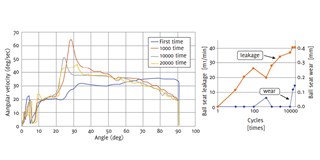^ Fig.1: Sensor used for experiment
Article by Mr. Isao Nishizawa and Lucien Joppen
___
Generally, the following two methods are used to gauge the condition of a valve. One is running to fail. For example, when the valve doesn’t work, the quality of the post-process is wrong, there is a strange noise, media will leak to the outside, and there is a strange odor.
Second, based on the knowledge that maintenance has been performed on a regular basis, an experienced maintenance engineer predicts and determines an appropriate replacement time. This is time-based maintenance.
The above methods apply basically for all valves. In general, valves installed in high-priority lines are subject to time-based maintenance.
Gyro sensor
In order to develop a method that can be used by less experienced maintenance personnel, Kitz came up with the concept of angular velocity to measure ball seat wear. The company experimented with various devices or measuring sticks such as encoders, gyro sensors, air flow meters, torque sensors, and air pressure types for highly- accelerated stress tests with steam (temperature 200°C, pressure 1.0MPa).
The reason Kitz focused on the gyro sensor was that there was a noticeable change in the angular velocity graph when a leak occurred. Temperature compensation and zero point calibration are performed so that sensor data is output correctly in any environment.
The angular velocity was also useful to determine whether the valve was moving smoothly. For example, if something goes wrong, such as foreign matter getting caught, the valve should stop during operation. Also, if the operating torque increases due to some abnormality, the movement of the valve will slow down.
Easy to install
The ball valve was moved by steam to make the ball seat wear until a leak occurred, then the company’s researchers observed the angular velocity. They found that if the ball seat wear progresses, the angular velocity changes. Especially, the characteristic was found in the angular velocity around 20 to 35 degrees after the valve started to move. The following graphs shows the changes in the number of operations, the wear amount, and the angular velocity. (Fig. 2)
The gyro sensor (angular velocity) was found to accurately capture the movement and angle of the valve, just like an encoder. There was also a correlation between angular velocity and torque. Kitz found that a gyro sensor that is easy to install is simple and useful. By using the sensor used in smartphones and other, similar devices, the price of the sensor can be kept low and it can be installed anywhere on the rotation axis.
Alert
In the future, in order to predict the health condition of the valve and detect abnormalities from the angular velocity, we are developing a system that attaches an IIoT sensor to the valve, collects data wirelessly to the cloud, and analyzes the data by AI. Customers will be able to check the information anytime and anywhere on a mobile devices. (Fig. 3) We have started pilot tests to acquire data with many fluids with the cooperation of customers. The acquired data will be transformed by AI to create algorithms for health condition prediction and the detection of abnormalities.
If an abnormality occurs, an alert will be sent to notify, and if deterioration over time occurs, Kitz is contemplating developing a mechanism to notify the recommended maintenance time from a certain feature value in the angular velocity.
Challenge
The system (gyro sensor and IIOT/AI) cannot be used in the field yet. As mentioned before, Kitz is busy developing an AI algorithm by collecting field data with the cooperation of its customers. Data stored in the cloud will be analyzed by AI algorithm. The challenge is to collect valve operation data in various environments so that AI can respond to various valve abnormalities.
Therefore, at first, the company thinks that it will be a proven and limited anomaly detection and prediction. By continuing to collect data, Kitz believes that AI will be able to handle various fluids and valves.




